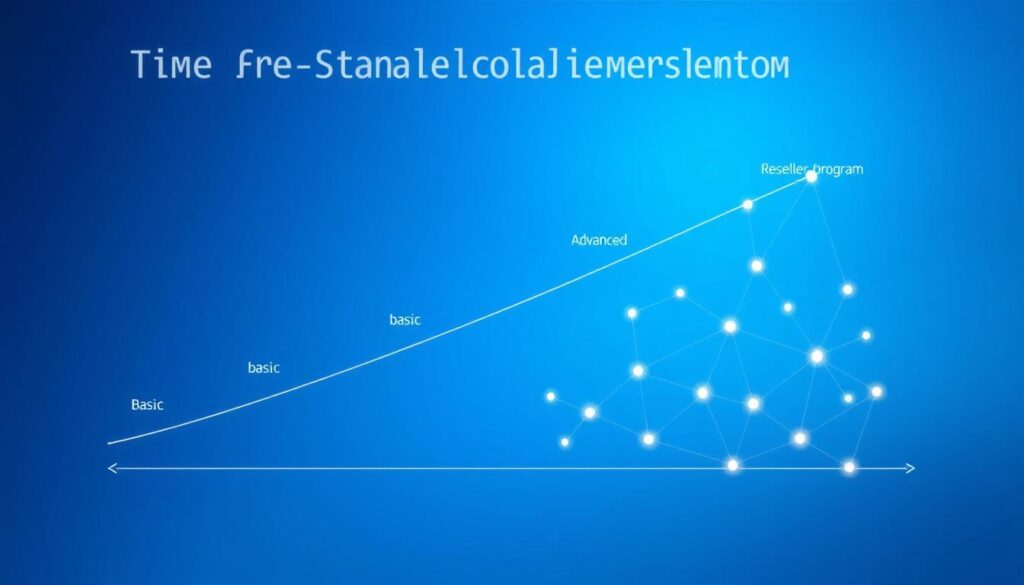Is your reseller channel program up to date in the tech sales world? As we enter 2024, vendors wonder if partner tiers are still useful or just old news.
For tech giants like Microsoft, VMware, and Oracle, channel partner programs are key to success. One B2B startup saw its revenue jump by 1,983% and its user base grow tenfold in six months.
But, up to 80% of channel sales have nonstandard prices. This shows how complex multi-tier distribution models are. It’s vital to know if partner tiers are essential for your channel’s success.
In this article, we’ll look at how channel partner programs are changing. We’ll discuss the good and bad of partner tiers and help you decide if they’re right for 2024. We’ll also explore other strategies that might work better for your business.
Key Takeaways
- Channel partner programs can significantly boost revenue and user base
- 80% of channel sales involve nonstandard pricing
- Partner tiers help vendors segment resellers based on various criteria
- Over 280 IT companies submitted applications for the CRN Partner Program Guide
- HubSpot’s Solutions Partner Program offers 20% commissions for advanced tiers
- 90% of customers will stop using a product if post-sale expectations aren’t met
Understanding the Importance of Channel Partner Programs

Channel partner programs are key in today’s business world. They help companies work well with their resellers, distributors, or service providers. Let’s explore why they’re so important.
Defining Channel Partner Programs
These programs are all about working together. They outline what’s expected, what benefits there are, and how support works. A good program lets companies grow and sell more through others.
The Impact on Business Growth
Choosing the right partners can really help a company grow. By using others’ skills and resources, businesses can reach new markets and customers. In fact, 98% of top IT partner programs use tiers to sort and prioritize partners.
These programs use different levels, like “good, better, best,” to sort partners. This helps companies manage their spending and match resources with what partners can do.
Success Stories from Industry Leaders
Many big names have grown thanks to good partner programs. For example, Microsoft and Oracle have huge partner networks that bring in a lot of money. Their success shows how powerful good partnerships can be.
“Partners represent our brand, handle our products, and assist in entering new markets. Our tiered program helps us manage investment levels based on reseller revenue and profit.”
But, traditional tiering might not always work. As partners deal with different markets and customers, companies need to check if their tier system fits. They should see if it supports all the different roles and types of partners they have.
The Evolution of Reseller Channel Programs

Reseller channel programs have changed a lot over time. They’ve evolved from simple partnerships to complex systems. Now, businesses work closely with partners to grow and reach new markets.
At first, these programs were just about selling products. Companies gave products to resellers, who then sold them to customers. But as the business world changed, so did these partnerships.
Now, reseller channel programs are complex systems. They have different levels and tracks for various partners. This way, businesses can match partners with their needs and goals.
The focus has moved from just selling products to creating valuable partnerships. These partnerships now drive innovation and make customers happier. Today’s programs use new technologies to manage and improve partner relationships.
Studies show most companies have 3-4 levels of partners. This helps in:
- Finding the right partners based on their skills and qualifications
- Checking if a partner fits with the company’s culture and values
- Creating plans to attract partners that match each level’s goals
The growth of reseller program levels shows the need for better strategies. By offering different levels, companies can support partners better. This helps partners grow and helps both sides succeed.
Key Components of a Successful Partner Program

To build a thriving partner program, you need a solid plan and hard work. We’ve found key elements that make a partner program successful.
Value Proposition Design
A strong value proposition makes your program stand out. It’s the heart of what makes your program different. Startups have grown fast with great value propositions.
One B2B startup grew its revenue by 1,983% and its user base by 1,000% in just six months.
Sales Process Optimization
Improving the sales process from the customer’s point of view is essential. This strategy helped a Swedish startup win 100 top telecom operators as clients. Knowing the buyer’s journey and focusing on the customer is crucial for success.
Partner Selection Criteria
Picking the right partners is key. Look for different types of partners like:
- Value-Added Resellers (VAR)
- Managed Service Providers (MSP)
- Consultants
- System Integrators (SI)
- Original Equipment Manufacturers (OEM)
- Independent Software Vendors (ISV)
- Distributors
- Agencies
Each partner type adds something special to your program. Focus on important factors like proof of concept, support quality, pricing, and project management. These help partners close deals and make your program thrive.
Reseller Channel Program: Do You Need To Have Partner Tiers?
Partner tiers are key in many reseller channel programs. They rank partners by performance and commitment. But, do you really need them? It depends on several factors.
For big programs with lots of partners, tiers are very helpful. They help focus resources and set clear goals for partners. For example, Arista’s Channels NOW! Partner Program has three levels: Authorized, Elite, and ElitePlus. Each level has its own rules and rewards, pushing partners to do better.
But, for new programs with just a few partners, tiers might be too early. A simpler setup could work better. The choice to use tiers should match your program’s size, partner number, and complexity.
HubSpot shows a different way. Their Solutions Partner Program uses tiers to measure success and reward growth. Partners move up tiers as they sell more. This system motivates partners to sell more.
“The success of a reseller partnership is interlinked with the vendor’s success,” notes a Manager of Partner Success.
In the end, whether you need tiers depends on your business needs and goals. Look at your current partners and future plans. Decide if a tiered system fits your strategy.
Benefits of Implementing Partner Tiers
Partner tiers bring big benefits to reseller channel programs. They create a system that helps everyone grow and work together better. Let’s look at the main benefits of this method.
Tactical Prioritization of Partners
By differentiating partner programs, we can focus better. We sort partners into tiers to help the best ones shine. This way, we make sure they get the help they need to do great.
Optimized Resource Allocation
With tiered systems, we can use our resources wisely. We give our best support to top-tier partners who show they’re serious and have big potential. This way, we make sure our efforts pay off the most, helping both us and our partners.
Natural Partner Incentivization
Partner tiers motivate partners to do better. They offer a clear way to grow, pushing partners to work harder and get better. This drive leads to a stronger, more skilled partner network.
“Partnership is the groundwork for achieving better results and sales with a remarkable payoff.”
Introducing tiered benefits has boosted partner happiness, sales support, and growth. Our program has three levels, giving partners lots of chances to advance. They get great marketing tools, top support, and valuable certifications, helping them and us succeed.
Designing an Effective Tiered Partner Structure
Creating a multi-tier distribution model needs careful planning. We must think about both company and partner needs. The goal is to offer clear benefits at each level and a clear path for advancement.
A well-designed partner program stratification can lead to big results. For example, bronze partners get 3% commission, silver partners 5%, and gold partners 8%. This tiered approach motivates partners to do better and move up.
Effective tier structures usually have at least three partnership levels. This setup encourages friendly competition among partners, pushing them to improve. It’s important to document what’s expected and what needs to be done at each level, ensuring everyone is on the same page.
When designing tiers, consider these key metrics:
- Partner-generated revenue
- Gross margin
- Sales growth
- Customer acquisition
- Deal registration conversion rate
These metrics help us see how well the program is doing and guide tier placement. Remember, being flexible is important. Your tiered structure should fit different partner types and their unique contributions. This way, you can create a more tailored and effective multi-tier distribution model.
“A well-structured partner program is the backbone of successful channel sales.”
By implementing a thoughtful partner program stratification, we can prioritize partners well, use resources wisely, and grow together. The outcome? A thriving ecosystem that benefits both the company and its partners.
Partner Tier Criteria and Requirements
Creating a partner segmentation strategy is key for a successful reseller program. We’ll look at the main criteria and requirements for setting up effective reseller program levels.
Performance Metrics
Performance metrics are crucial in setting partner tiers. These metrics include customer satisfaction, deal closure rates, and market penetration. For example, AWS requires partners to meet certain MRR milestones for each tier.
Training and Certification
Partner education is vital for program quality. AWS sets specific training and certification requirements for each tier:
- Select Tier: 42 technical and 2 business professionals
- Advanced Tier: 84 technical and 4 business professionals
- Premier Tier: 210 technical and 10 business professionals
Sales Volume Thresholds
Sales performance is a key factor in tier placement. Higher tiers need more sales achievements. Studies show that good tier systems can boost website traffic by up to 10% and increase conversion rates by 3%.
By setting clear criteria for each tier, businesses can encourage goal-oriented performance. This approach motivates partners to move up the tier ladder. It also helps in optimizing resource allocation in the channel program.
Motivating Partners to Climb the Tier Ladder
Motivating partners to move up the tiers is key for a channel program’s success. Over 50% of companies use tiered partner structures, showing it’s effective. Our models aim to make each tier more appealing with better incentives.
Tiered benefits are a big motivator for growth. For example, Zendesk’s three-tier program gives Tier 3 partners qualified leads. This boosts their sales chances. It encourages partners to aim for higher tiers, leading to more engagement and better performance.
Financial rewards are a strong motivator. We use graduated commission structures, where higher tiers get more. This has shown to increase sales volume and market share.
- Access to advanced training opportunities
- Enhanced marketing support
- Exclusive events and recognition programs
- Priority technical support
We offer unique benefits at each tier to make growth worth it. Our data-driven approach helps us keep the program appealing and competitive. This ensures it stays attractive in the changing channel landscape.
Case Studies: Successful Tiered Partner Programs
We’ve looked at partner tiers in reseller channel programs. Now, let’s see real examples. They show how to make your program stand out and if you need tiers.
Juniper Partner Advantage
Juniper Networks has a tiered program. It helps partners know where they are and where they can grow. This makes it easier for them to set goals and see how they’re doing.
HubSpot Solutions Partner Program
HubSpot’s program shows how to use resources wisely based on partner tiers. It gives different support and benefits to each tier. This way, the best partners get what they need to succeed.
VMware Partner Connect
VMware’s Partner Connect program shows how tiers can make partners work better. It has three levels – Partner, Advanced Partner, and Principal Partner. Each level has its own path to making money.
Principal Partners need Master Services Competencies for better rebates and chances to sell together.
These programs show the good of tiered systems. They make partners more involved, use resources better, and make the program work better. For example, VMware gives special perks like partner portals and funds for marketing.
Thinking about tiers in your program? Remember, 41% of partnership pros like tiered programs. This means tiers can really help your program stand out and get partners to do their best.
Challenges in Implementing Partner Tiers
Setting up a multi-tier distribution model is complex for businesses. Partner programs offer many benefits but also face challenges. We’ve found several major hurdles for companies in creating tiered partner programs.
Managing partner expectations is a big obstacle. Partners have different goals and needs, making a universal approach hard. If partners don’t see their needs met, they might get frustrated and disengage.
Making sure partners can move up fairly is another big challenge. Companies need to set clear, reachable goals for advancement. But, this balance can be tricky, leading to resentment among partners who feel they’re not moving up fast enough.
- Resistance from partners who feel disadvantaged
- Balancing needs of different partner types
- Administrative burden of managing tiers
- Increased competition among partners
Managing a tiered system is a big job. It takes a lot of time to track performance, provide tier-specific resources, and keep in touch with all partners. This can be overwhelming and might slow down the program’s success.
According to the Aberdeen Group, properly implemented partner programs result in 13% more sales reps achieving their quotas and 28% shorter sales cycles.
Despite the challenges, the benefits of a good partner program often outweigh the problems. By tackling these issues head-on and keeping the lines of communication open, businesses can build a successful multi-tier model. This model can help grow the business and strengthen partnerships.
Alternatives to Traditional Partner Tiers
In 2024, reseller program levels are changing. New strategies offer more flexibility and focus. They aim to better serve different partners and help them grow.
Flexible Partner Tracks
Flexible tracks let partners pick their areas of focus. This way, companies can recognize and use each partner’s strengths. It helps in building stronger, more successful partnerships.
Specialization-Based Programs
These programs reward partners for their deep knowledge in certain areas. For example, a partner might focus on cybersecurity for healthcare. This approach helps partners offer more value to customers.
Hybrid Models
Hybrid models mix traditional tiers with specialization tracks. They offer structure and flexibility. Check Point’s program is a good example, starting as a reseller but adding more revenue streams.
These new strategies provide more tailored experiences. They fit different partner ecosystems and lead to better partnerships. As the channel world changes, we’ll see more companies using these flexible approaches.
“Our new partner program allows resellers to choose their own path. It’s not one-size-fits-all anymore. We’re seeing increased engagement and better results.”
Conclusion
In 2024, the question “Do you need to have partner tiers in your reseller channel program?” is still important. We’ve looked into how partner program differentiation affects business growth. Whether to use tiers depends on your program’s level and partner network.
Channel sales can really change the game. One channel manager can do as much as many salespeople at a lower cost. This approach is great for testing new markets and products efficiently. Choosing a few, top-notch partners can lead to more revenue and strong partnerships.
Partner tiers have their perks, like getting more attention and using resources better. But, they also have downsides. Deal registration, for example, helps avoid channel conflicts and gives vendors insight into the pipeline. The speed of approval and what partners get paid can change based on their tier.
In the end, the best setup depends on your specific situation. Whether you go for tiers or something else, aim to create a program that grows together. A good reseller channel program fits your sales process and asks for manageable commitments from partners.

